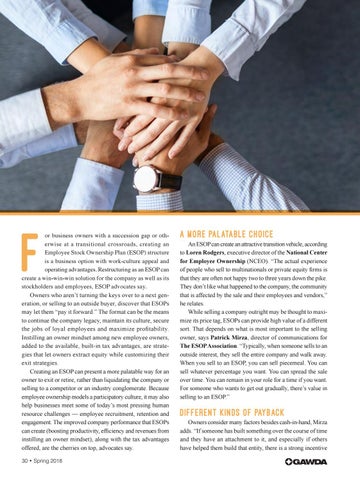F
or business owners with a succession gap or otherwise at a transitional crossroads, creating an Employee Stock Ownership Plan (ESOP) structure is a business option with work-culture appeal and operating advantages. Restructuring as an ESOP can create a win-win-win solution for the company as well as its stockholders and employees, ESOP advocates say. Owners who aren’t turning the keys over to a next generation, or selling to an outside buyer, discover that ESOPs may let them “pay it forward.” The format can be the means to continue the company legacy, maintain its culture, secure the jobs of loyal employees and maximize profitability. Instilling an owner mindset among new employee owners, added to the available, built-in tax advantages, are strategies that let owners extract equity while customizing their exit strategies. Creating an ESOP can present a more palatable way for an owner to exit or retire, rather than liquidating the company or selling to a competitor or an industry conglomerate. Because employee ownership models a participatory culture, it may also help businesses meet some of today’s most pressing human resource challenges — employee recruitment, retention and engagement. The improved company performance that ESOPs can create (boosting productivity, efficiency and revenues from instilling an owner mindset), along with the tax advantages offered, are the cherries on top, advocates say. 30 • Spring 2018
A MORE PALATABLE CHOICE An ESOP can create an attractive transition vehicle, according to Loren Rodgers, executive director of the National Center for Employee Ownership (NCEO). “The actual experience of people who sell to multinationals or private equity firms is that they are often not happy two to three years down the pike. They don’t like what happened to the company, the community that is affected by the sale and their employees and vendors,” he relates. While selling a company outright may be thought to maximize its price tag, ESOPs can provide high value of a different sort. That depends on what is most important to the selling owner, says Patrick Mirza, director of communications for The ESOP Association. “Typically, when someone sells to an outside interest, they sell the entire company and walk away. When you sell to an ESOP, you can sell piecemeal. You can sell whatever percentage you want. You can spread the sale over time. You can remain in your role for a time if you want. For someone who wants to get out gradually, there’s value in selling to an ESOP.”
DIFFERENT KINDS OF PAYBACK Owners consider many factors besides cash-in-hand, Mirza adds. “If someone has built something over the course of time and they have an attachment to it, and especially if others have helped them build that entity, there is a strong incentive
